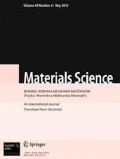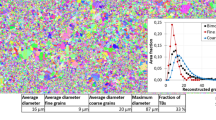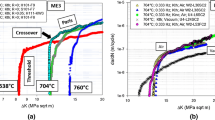We study the macro- and microfractographic features of the mechanism of initiation and propagation of fatigue cracks in the nitinol alloy after its testing for low-cycle fatigue and analyze possible influence of the structural and phase transformations caused by the cyclic deformation of nitinol on the fractographic features of its fatigue fracture. Thus, almost parallel transcrystalline facets of brittle cleavage located in almost mutually perpendicular planes along the entire length of martensite crystals are observed within the boundaries of separate grains (first of all, in the early stages of fracture). The signs of shallow fatigue striations are detected (but rarely) in the zone of the stable growth of the fatigue crack. The spacing of these striations approximately corresponds to a crack-growth rate of 8 ∙ 107 m/cycle. It is suggested that the deformation transformation of austenite into martensite can also distort the classical deformation mechanism of formation of the fatigue striations. In the zones of fractures with uncontrolled crack growth, the elements of ductile pit topography are predominant, which is typical of the fracture surfaces of specimens destroyed under active loading.



Similar content being viewed by others
References
G. Kang and D. Song, “Review on structural fatigue of NiTi shape memory alloys: Pure mechanical and thermo-mechanical ones,” Theor. Appl. Mech., 5, No. 6, 245–254 (2015).
S. Miyazaki, S. Kimura, F. Takei, T. Miura, K. Otsuka, and Y. Suzuki, “Shape memory effect and pseudoelasticity in a TiNi single crystal,” Scr. Metall., 17, No. 9, 1057–1062 (1983).
F. Auricchio, E. Boatti, and M. Conti, “SMA biomedical applications,” in: L. Lecce and A. Concilio (editors), Shape Memory Alloy Engineering, Butterworth–Heinemann, Boston (2015), pp. 307–341.
V. Torra, C. Auguet, G. Carreras, L. Dieng, F. C. Lovey, and P. Terriault, “The SMA: An effective damper in civil engineering that smoothes oscillations,” Mater. Sci. Forum, 706–709, 2020–2025 (2012).
P. Yasniy, M. Kolisnyk, O. Kononchuk, and V. Iasnii, “Calculation of constructive parameters of SMA damper,” Sci. J. TNTU, 88, No. 4, 7–15 (2017).
D. J. Hartl and D. C. Lagoudas, “Aerospace applications of shape memory alloys,” Proc. Inst. Mech. Eng. Part G. J. Aerosp. Eng., 221, No. 4, 535–552 (2007).
S. W. Robertson, A. R. Pelton, and R. O. Ritchie, “Mechanical fatigue and fracture of Nitinol,” Int. Mat. Reviews, 57, No. 1, 1–36 (2012).
V. Iasnii, P. Yasniy, Yu. Lapusta, and T. Shnitsar, “Experimental study of pseudoelastic NiTi alloy under cyclic loading,” Sci. J. TNTU, 92, No. 4, 7–12 (2018).
V. P. Iasnii, H. M. Nykyforchyn, O. T. Tsyrul’nyk, and O. Z. Student, “Specific features of deformation of the nitinol alloy after electrolytic hydrogenation,” Fiz.-Khim. Mekh. Mater., 54, No. 4, 124–130 (2018); English translation: Mater. Sci., 54, No. 4, 582–588 (2019).
V. Iasnii and P. Yasniy, “Influence of stress ratio on functional fatigue of pseudoelastic NiTi alloy,” Proced. Struct. Integrity, 16, 67–72 (2019).
V. Iasnii and P. Yasniy, “Degradation of functional properties of pseudoelastic NiTi alloy under cyclic loading: an experimental study,” Acta Mech. Autom., 13, No. 2, 95–100 (2019).
O. Z. Student, W. Dudzinski, H. M. Nykyforchyn, and A. Kaminska, “Effect of high-temperature degradation of heat-resistant steel on mechanical and fractographic peculiarities of fatigue crack growth,” Fiz.-Khim. Mekh. Mater., 34, No. 4, 49–58 (1999); English translation: Mater. Sci., 35, No. 4, 499–508 (1999).
P. O. Maruschak, D. Ya. Baran, A. P. Sorochak, R. T. Bishchak, and V. P. Yasnii, “Cyclic crack resistance and micromechanisms of fracture of steel 25Kh1M1F,” Strength Mater., 44, No. 4, 410–418 (2012).
L. Poberezhnyi, P. Maruschak, O. Prentkovskis, I. Danyliuk, T. Pyrig, and J. Brezinová “Fatigue and failure of steel of offshore gas pipeline after the laying operation,” Arch. Civil Mech. Eng., 16, No. 3, 524–536 (2016).
Y. Murakami and R. O. Ritchie, “Effects of hydrogen on fatigue-crack propagation in steels,” in: R. P. Gangloff and B. P. Somerday (editors), Gaseous Hydrogen Embrittlement of Materials in Energy Technologies: The Problem, Its Characterization and Effects on Particular Alloy Classes, Vol. 1, Woodhead Publ., Cambridge (2012), pp. 379–417.
V. P. Iasnii, O. Z. Student, and H. M. Nykyforchyn, “Influence of hydrogenation on the fracture of nitinol alloy in tension,” Fiz.-Khim. Mekh. Mater., 54, No. 3, 80–85 (2019); English translation: Mater. Sci., 55, No. 3, 386–391 (2019).
Author information
Authors and Affiliations
Corresponding author
Additional information
Translated from Fizyko-Khimichna Mekhanika Materialiv, Vol. 55, No. 5, pp. 148–153, September–October, 2019.
Rights and permissions
About this article
Cite this article
Iasnii, V.P., Nykyforchyn, H.M., Student, O.Z. et al. Fractographic Features of the Fatigue Fracture of Nitinol Alloy. Mater Sci 55, 774–779 (2020). https://doi.org/10.1007/s11003-020-00370-9
Received:
Published:
Issue Date:
DOI: https://doi.org/10.1007/s11003-020-00370-9




